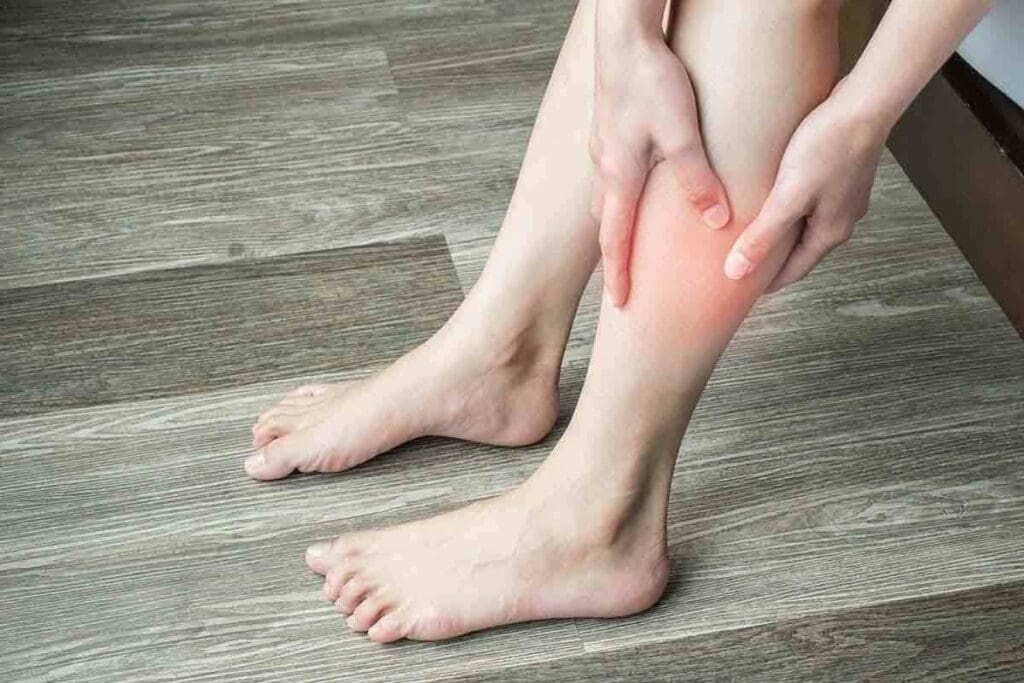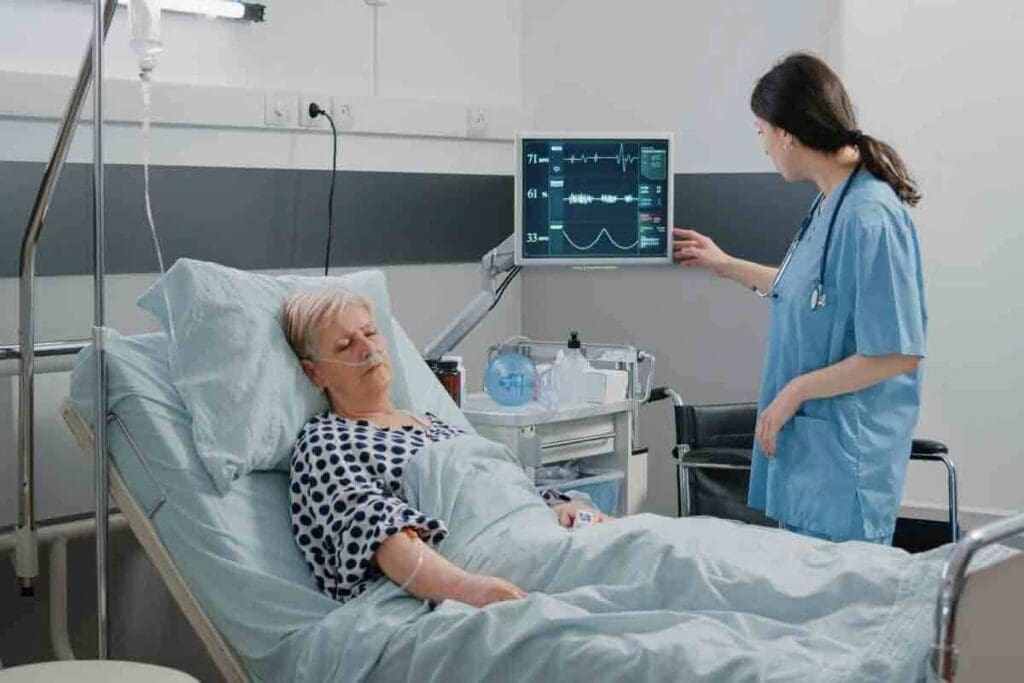Last Updated on November 17, 2025 by Ugurkan Demir

Upper extremity deep vein thrombosis (DVT), or thrombosis of the arm, is when a blood clot forms in the deep veins of the arm. It can cause sudden swelling, redness, or a bluish color. You might also feel pain or a heavy feeling in the area.
Blood clots in arms are often linked to health issues like cancer. They can also be caused by medical devices like catheters or pacemakers. Many people wonder, can you get a blood clot in your arm, and the answer is yes—sometimes too much activity or certain body shapes can contribute to this problem.

Blood clots in the arm are serious and need quick medical help. Upper extremity deep vein thrombosis (UEDVT) is when a blood clot forms in the deep arm veins.
UEDVT happens when a blood clot forms in the deep arm veins. It can be caused by injury, repetitive arm movements, certain health conditions, or intravenous catheters. Medical sources say DVT often occurs in the legs but can also happen in the arms, abdomen, or brain.
Arm blood clots are less common than leg DVT. But, they can happen to people with certain risk factors, like those with catheters or who do repetitive arm movements. Knowing these risks is key to preventing and catching them early.
The structure of arm veins is important for clot formation. The deep arm veins are more likely to clot due to stasis, hypercoagulability, and injury to the vein lining. Understanding the arm’s venous anatomy is vital for diagnosing and treating UEDVT well.

Can you get a blood clot in your arm? It depends on the type and cause. Blood clots in the arm, or upper extremity deep vein thrombosis (UEDVT), come in two forms: primary and secondary.
Primary UEDVT is rare and linked to hard or repetitive arm work. It makes up to 20% of UEDVT cases. Secondary DVT happens when blood flow is blocked, often by an intravenous catheter or device in the arm.
Primary Thrombosis: This type is caused by strenuous or repetitive activities. These activities can hurt the vein walls, leading to clotting.
Secondary Thrombosis: Medical devices like catheters can disrupt blood flow. This increases the risk of clotting.
| Characteristics | Primary Thrombosis | Secondary Thrombosis |
| Causes | Strenuous or repetitive arm activity | Use of intravenous catheters or other devices |
| Incidence | Up to 20% of UEDVT cases | More common than primary thrombosis |
The clotting process in arm veins is complex. It involves many factors that can lead to clot formation. When a vein is injured, the body forms a clot to stop bleeding. Sometimes, a clot forms without injury, due to slowed blood flow or increased clotting tendency.
Arm and leg blood clots form in a similar way, but their causes and effects differ. Leg clots are more common and linked to immobility or long travel. Arm clots are often caused by medical devices or hard work.
Arm clots might feel tight or tender, but not all are noticeable. Knowing these differences is key for proper diagnosis and treatment.
It’s important to know the signs of a blood clot in the arm. This can help prevent serious problems. Blood clots in the arm show up in different ways.
Symptoms of a blood clot in the arm include sudden swelling and redness. You might also see bluish discoloration, pain, or bulging veins. Warmth around the area is another sign.
A blood clot in the arm can make the area swell, turn red, or change color. It might feel warm to the touch. Veins may look more prominent or bulge.
In some cases, the skin might turn bluish. This happens when the clot blocks blood flow.
Yes, you can feel a blood clot in your arm. It might hurt or feel heavy. The area might be tender or painful when you move it.
It’s key to watch for these signs and get medical help if you notice them. Quick action can make a big difference.
Many things can make you more likely to get blood clots in your arms. These include health conditions and lifestyle choices. Knowing these risks helps prevent and manage blood clots in the arms.
Some health issues can raise your risk of getting blood clots in your arms. These include:
How you live and your environment also affect your risk of arm blood clots. These include:
Using central venous catheters or PICCs can increase your risk of blood clots in your arm. These can irritate veins, leading to clots.
Effort-induced thrombosis, or Paget-Schroetter syndrome, is when a blood clot forms in the arm from hard work or repetitive actions. It’s more common in young, healthy people who do a lot of arm work.
Knowing these risk factors helps you take steps to prevent blood clots. If you’re at higher risk, watch for signs and symptoms of arm blood clots. See a doctor if you notice any unusual discomfort or swelling in your arms.
It’s important to know about blood clots in different parts of the arm. They can happen in the upper arm, elbow, forearm, and wrist. Most clots form in the upper arm, but they can also occur in other areas.
Upper arm thrombosis is a blood clot in the upper arm’s deep veins. It’s less common than leg clots but can be painful. Symptoms include swelling, pain, and warmth.
Key factors that increase the risk of upper arm thrombosis include:
A blood clot in the elbow is serious because of its complex anatomy. Clots can come from injuries, trauma, or conditions like thoracic outlet syndrome.
Common concerns associated with elbow blood clots include:
Blood clots in the forearm and wrist are rare but can happen. They often result from injuries, strain, or catheter placement. Symptoms include pain, swelling, and limited mobility.
It’s essential to seek medical attention if you experience:
Doctors use many methods to find arm blood clots. They start with basic checks and then use special imaging. Finding these clots quickly is important. If not treated fast, they can move to the lungs and cause pulmonary embolism, which is very dangerous.
The first step is checking the patient’s history and doing a physical exam. Doctors look for swelling, pain, and color changes in the arm.
Imaging tests are key in finding arm blood clots. Here are some common ones:
| Imaging Test | Description | Usefulness in Diagnosing Arm Blood Clots |
| Ultrasound | Non-invasive; uses sound waves | High; can detect clots and assess blood flow |
| Venography | Involves contrast dye injection | High; provides detailed images of veins and clots |
Laboratory tests, like the D-dimer test, help confirm the diagnosis. The D-dimer test checks for a protein fragment from dissolving blood clots.
It’s important to tell arm blood clots from other conditions that look similar. These include muscle strain or cellulitis. A detailed check helps make the right diagnosis.
Getting the diagnosis right is key to treating it well and avoiding serious problems. Doctors use medical checks, imaging, and lab tests together. This way, they can find arm blood clots accurately and start the right treatment.
There are many ways to treat arm blood clots, from medicine to surgery. Finding the problem early is key. This helps avoid serious issues and gets the best results.
Medicine is a big part of treating arm blood clots. The main goals are to stop the clot from getting bigger, ease symptoms, and keep it from breaking loose and moving to the lungs or other areas.
A medical expert says, “Anticoagulants have changed how we treat deep vein thrombosis. They greatly lower the risk of pulmonary embolism and other issues.”
“Anticoagulation therapy is the key to treating deep vein thrombosis. It balances stopping clot growth and avoiding bleeding problems.”
Sometimes, just medicine isn’t enough. Then, surgery or other procedures might be needed.
| Procedure | Description | Indications |
| Thrombectomy/Embolectomy | Surgical removal of the clot | Severe symptoms, high risk of complications |
| Surgical Decompression | Relieving pressure on the vein | Paget-Schroetter Syndrome, significant swelling |
How long it takes to get better depends on the clot’s size and the treatment. Most people start feeling better in a few days to a week after starting treatment.
It’s very important for patients to stick to their treatment plan. They should also go to all follow-up appointments. This helps keep track of their progress and makes any needed changes.
Blood clots in the arm can cause serious problems if not treated fast. These issues can really affect a person’s life quality. In some cases, they can even be deadly.
Understanding the Risks
Pulmonary embolism (PE) is a major risk from arm blood clots. If not treated quickly, clots can move to the lungs. This can block blood flow and is very dangerous.
“A pulmonary embolism occurs when a blood clot gets lodged in an artery in the lung, blocking blood flow to the lung,” say doctors. A PE can happen fast, even within days after a blood clot forms in your arm. Getting medical help right away is key to avoiding this.
Post-thrombotic syndrome (PTS) is another possible issue from arm blood clots. PTS happens when the blood clot damages vein valves. This leads to chronic symptoms like pain, swelling, and limited arm movement.
The risk of getting PTS can be lowered with the right treatment and care for the initial blood clot.
People who have had an arm blood clot are at risk of it happening again. Risks include underlying health issues, genetic factors, and lifestyle choices. Knowing these risks is important for stopping future clots.
The future after an arm blood clot depends on many things. These include how well treatment works and any underlying health issues. With good care, many people can fully recover. But, some might face long-term problems like PTS.
It’s vital for patients to stay close to their healthcare team. This helps manage their condition and avoid future problems.
Preventing blood clots in the arm requires lifestyle changes and knowing the risks. Liv Hospital focuses on international care standards and patient needs. To lower DVT risk, avoid smoking, move often, stay healthy, exercise, and drink plenty of water.
For those at higher risk or with clot history, taking blood thinners is key. This helps prevent blood clots.
Knowing when to get medical help is also vital. If you notice swelling, pain, or color changes in your arm, see a doctor right away. Early treatment can save lives and prevent serious problems like pulmonary embolism.
By following these prevention tips and watching for warning signs, you can lower your risk of arm blood clots. Liv Hospital is committed to top-notch care and the latest treatment methods for the best results.
A blood clot in the arm can make the area swell, turn red, and feel warm. The skin might look discolored or bruised. Sometimes, you can see a lump or a cord-like structure along the vein.
Yes, a blood clot in the arm can feel tender or painful. It might feel heavy or tight. Moving the arm or applying pressure can also cause pain.
Common signs include swelling, pain, redness, warmth, and tenderness. You might also feel a heavy or tight sensation in the arm. Pain when moving the arm is another sign.
To know if you have a blood clot, look for swelling, pain, redness, and warmth. If you notice these, get medical help. A doctor will examine you, take your medical history, and might do imaging tests.
Blood clots in the arms can come from many things. Medical conditions, lifestyle, and injury are common causes. Conditions like cancer or clotting disorders can also play a role.
Yes, they can be dangerous. If they break loose and go to the lungs, it’s a pulmonary embolism. They can also lead to post-thrombotic syndrome, causing chronic pain, swelling, and skin discoloration.
Doctors diagnose blood clots through physical exams, medical history, and imaging tests. Tests like ultrasound, venography, or CT scans might be used.
Treatment includes anticoagulant medications, thrombolytic therapy, and sometimes surgery. The goal is to stop the clot from growing, ease symptoms, and prevent complications.
Yes, blood clots can happen in the upper arm, like in the axillary and subclavian veins. Many factors can cause them, including medical conditions, lifestyle, and injury.
Upper extremity deep vein thrombosis (UEDVT) is when a blood clot forms in the deep veins of the arm. It can cause swelling, pain, and redness in the affected arm.
To prevent blood clots, stay healthy with regular exercise and a balanced diet. Avoid sitting for long periods and manage any health conditions. Proper care of catheters or medical devices is also important.
Subscribe to our e-newsletter to stay informed about the latest innovations in the world of health and exclusive offers!